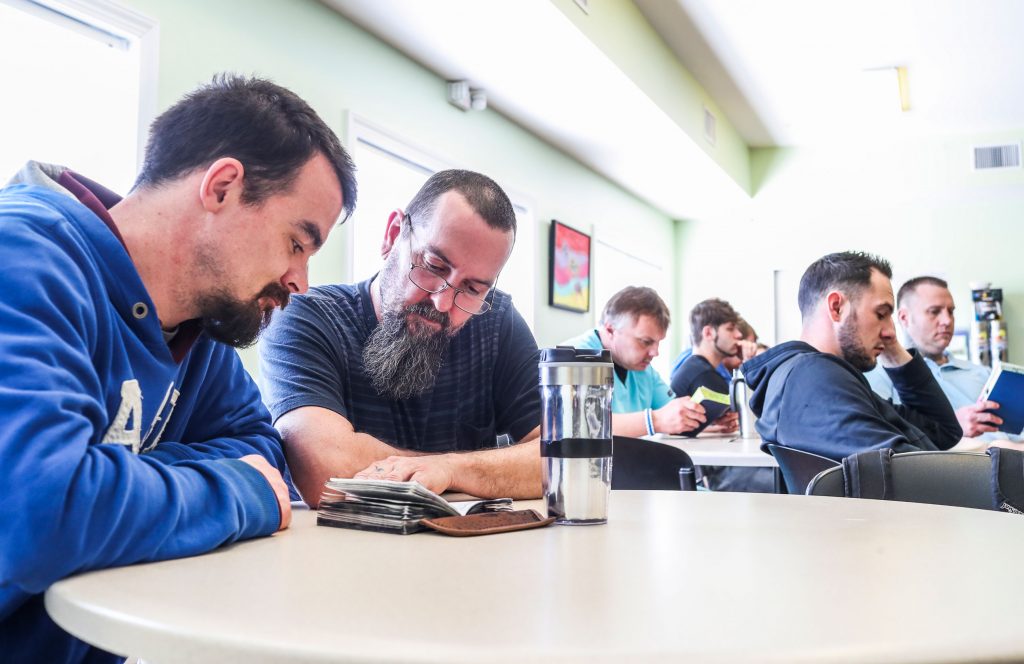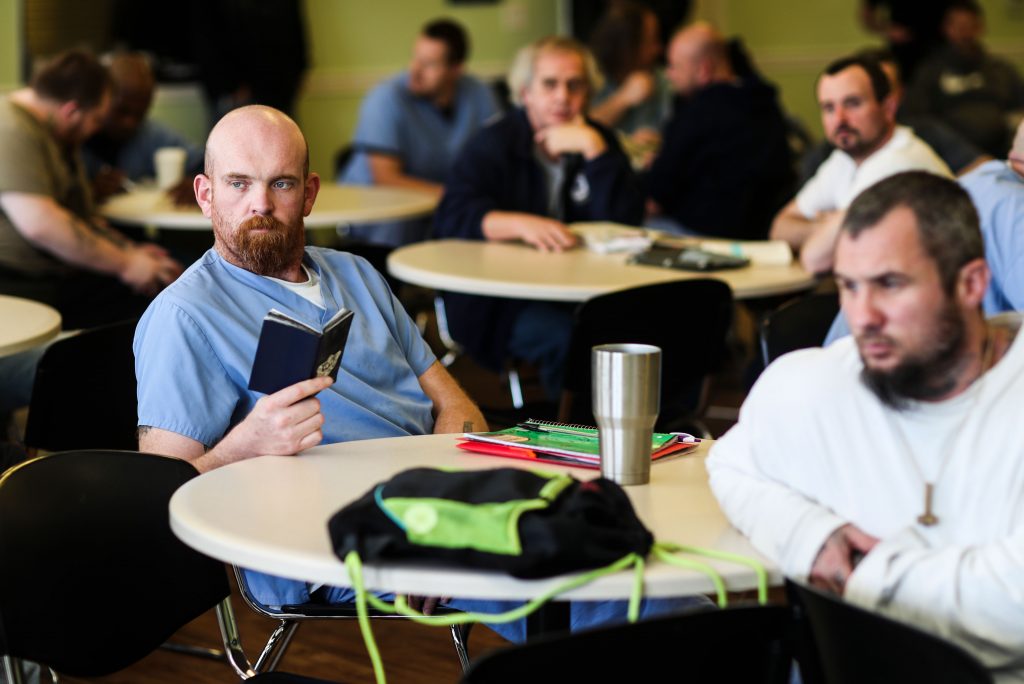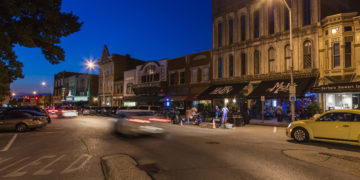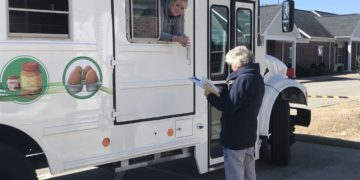Those who traverse downtown Bowling Green on a regular basis may see groups of men walking together, traveling from the north end of town.
To the average person, it may seem as though the men are simply taking a stroll, enjoying fellowship. But there is more than meets the eye. These men are completing the second step of a life-changing recovery process at Men’s Addiction Recovery Campus.
“They call it trudging,” said Nicole Frields, vice president of recovery services at MARC. “They go to offsite classes. That is to promote camaraderie amongst everybody and to get to know each other. The trudging part is to show the motivation.”
On the other hand, those traveling through Bowling Green may pass by a seemingly regular home, unaware that women’s lives are being transformed inside its walls.
That’s because private recovery homes are nondescript, preserving the anonymity of its residents. One such home is Vision of Hope, which has received renovation and repair help from the men at MARC.
MARC, which opened its doors in June 2016, is a state-run inpatient substance abuse recovery program for adult men and utilizes a social model of recovery.
“We’re a peer-driven program, so all of our staff are people that are in recovery,” Frields said. “This shows that, ‘Hey if he can do it, I can do it,’ and they’re going to respect what that person says because they’ve been down the same road.”
While at MARC, clients must adhere to a long list of stringent rules, which include random alcohol and drug testing, a 10 p.m. curfew and being smoke-free during program hours.
The program at MARC includes four steps, beginning with Safe off the Streets, Frields said. During SOS, clients become acclimated to group living and the structure of the recovery program.
“They stay in SOS for at least 10 days,” Frields said. “We have someone here 24 hours a day that makes sure that if they’re experiencing any sort of withdrawal symptoms that we can be there and treat those.”
After SOS, men move onto the second step known as Motivational Track. In MT, residents continue to live at the facility but spend the majority of the day off-site in educational classes and attending support group meetings.
Once Motivational Track is completed, clients begin the penultimate step of the program: Phase One.
“Phase One is kind of the meat and potatoes of the program,” Frields said.
During this phase, residents begin to work in depth with the Twelve Steps of Alcoholics Anonymous and meet with their peers three times per week.

Frields said the Twelve Steps can be applied to all addictions.
“The way that we explain addiction is in regard to the alcoholic personality,” Frields said. “So everybody has kind of the same thinking and the Twelve Steps seem to work with everybody.”
After Phase One, clients enter Phase Two. The men in the final phase are still accountable for abiding the rules and the curfew of MARC, but are able to drive and get jobs if they wish. To stay at MARC, they must pay rent, Frields said.
“As long as we don’t feel it’s hindering their recovery, we’ll allow them to stay as long as needed,” Frields said. “At the end of Phase Two, they petition their community and ask their peers to approve their plan to go home, and if everyone approves their plan then they go home.”
Once a year, MARC invites their alumni back for a fun-filled and celebratory homecoming.
“We have an alumni picnic where we bring everybody back together and we have pony rides, cotton candy, a dunking booth and bouncy castles, and they’re welcome to bring their children,” Frields said.
On any given day, MARC is at or over its capacity of 107 beds.
“We stay full all the time,” Frields said. “If we have somebody that desperately needs to get in, we have cots. That’s just on an emergency basis. We don’t like to turn anyone away because a lot of times it’s life or death. This person may not have anywhere else to turn.”
Frields said that MARC clients come from all over the country—not just the Bowling Green area.
“We’ve had clients from Arizona, California and Virginia from just word of mouth,” she said. “Somebody knows somebody that knows somebody that knows about us.”
At MARC, each client must pull his weight around the facility. Frields said the men in the program represent many different skill sets.
“Everybody has a job in the house,” Frields said. “Our men mow the grass, they do the laundry, they cook all the food, they do all the housekeeping. If we need a coat of paint somewhere, they’ll paint. If we have a toilet that needs to be snaked, somebody here knows how to do that.”
While at MARC, clients are also afforded opportunities to volunteer around the community at organizations such as the Salvation Army and Habitat for Humanity. At times, the men take on renovation or repair projects at private recovery homes in the community.
“They do a little bit of everything,” Frields said. “This teaches them that they need to give back. Addicts and alcoholics are very selfish people. And the guys love it.”
Amenities at MARC include a chapel, dining hall, dormitories and individual apartments.
“We have something going on all of the time—it’s constantly moving here,” Frields said. “The chapel was put in for prayer and meditation because that’s a big part of the recovery program. So they have a quiet place to go during the hustle and bustle of the day.”
In the beginning stages of development, MARC encountered some pushback from existing area organizations, citing safety concerns.
But since its opening, no complaints have been filed against the organization.
“We have not had one ounce of trouble,” Frields said.
In fact, Frields said MARC and other Recovery Kentucky programs have seen great success rates.
According to the University of Kentucky Center on Drug and Alcohol Research, Recovery Kentucky clients reporting use of any illicit drugs and/or alcohol at intake is 84.4 percent, but at follow-up is just 6.3.

MARC’s counterpart, Women’s Addiction Recover Manor, in Henderson, Ky., is where Frields got her start.
“You get people from all walks of life,” Frields said. “I was in treatment myself in 2006. I was at the Hope Center in Lexington. (Recovery Kentucky) centers are basically models of the Hope Center. I applied for a job while I was in Phase Two, and I got hired at WARM to work at the front desk.”
Eventually, Frields moved to her current position, splitting her time between MARC and WARM.
“I wear a lot of hats,” she said. “I’ve got a lot of irons in the fire. I’m basically the problem solver.”
Frields said she believes there is a need for a large center that caters to women recovering from addiction in the Bowling Green community. Currently, she said more than 15 women from the Bowling Green area are residents at WARM.
There are a handful of private recovery homes for women in the community.
Amber Hamm is Vision for Hope’s owner and live-in director. She is looking forward to the home moving locations this year.
The new home, which will increase its size from six to seven beds for women in recovery, will also include amenities like a fenced-in backyard and patio. Hamm said the new house is currently undergoing renovations, getting repainted and new carpet.
Vision of Hope, formerly known as Her Path, was founded in July 2014 by Rachel Wheat.
At its first location, Wheat and her two children lived on the first floor and had eight beds upstairs for women looking to recover.
“I thought, ‘We’ll move in and then we’ll fill it in like a month,’” Wheat said. “In four days, I had people sleeping on the floor. There was just that great of a need for beds.”
What compelled Wheat to undertake such a project?
When she was going through her own struggles of addiction, she had a support system in her family. But not everyone going through addiction has that, she said.
“Where are they going to go?” Wheat said she asked herself. “Where do you go when you need a soft place to land but a firm enough place to start from?”
And Her Path became that place to go, she said.
“We got to be a part of really neat things,” Wheat said. “We’ve been a part of women’s lives and see families come back together—moms learn how to be moms again or for the first time even.”
Hamm, who is now 15 months clean, first found sobriety at Her Path before taking on her new role.
In 2016, Hamm said she was in her 16th treatment center and was finally referred to Wheat.
“I can say personally that Rachel came and got me out of a motel room,” Hamm said. “If I had not come to a recovery home from the motel room—had I not taken that continuum of care—I would be dead.”
Hamm said sobriety can be lonely and that having a support system helps.
“I spent a lot of time alone when I first got sober,” Hamm said. “I went through some really, really heavy stuff. Having a house director I could reach out to was a big deal. I want that with them. Things happen that are unexpected. We’re going to experience death. We’re going to experience loss. Having support from Rachel and my sponsor was great. They were always my first two phone calls. Having that—that’s what these places are for.”
Hamm said there is high demand for women’s recovery homes in Bowling Green.
“We could keep a waiting list 365 days a year,” Hamm said. “There’s always a need. I hope we get more women’s houses. It’s not a competition.”
Unlike Recovery Kentucky programs like MARC, independently run recovery homes typically charge rent. Hamm said current rent at Vision of Hope is $105 per week and the cost covers all utilities.
Typically, the program lasts 12 months.
“I don’t know anyone who can get their life together in just six months,” Hamm said.
She said the women must learn accountability during their recovery by keeping up rent payments, making money and saving money. Then, they are ready to graduate.
All residents are required to have a sponsor, Hamm said.
“We do check-ins every week,” Hamm said. “Sponsors have to sign a sheet of paper saying they’ve met in-person once and have had three phone calls. If they’re working (the twelve) steps, working with a sponsor and attending meetings, everything else will fall into place.”
Hamm said she stays on a twin bed and has small space in the fridge just like the other women in the home.
“I don’t consider this house to be mine,” Hamm said. “This is our house. We’re doing this together. We’re all dealing with one thing, and that’s addiction.”
Hamm said she is working to make every woman who comes from the program capable of living on her own.
“The goal is to come in here, get sustainable and move out,” Hamm said. “Not to move from one recovery home to another. But they have to be taught that. I had to learn that.”
There is a screening process to be accepted at Vision of Hope.
“I do get to be selective about who I take,” Hamm said. “All it takes is one person to come in here to really cause some damage. I’ve seen it happen, and it creates a domino effect.”
Wheat said there will always be those who aren’t aware of how a recovery home like Vision of Hope operates. In fact, she said there was an individual initially opposed to Hamm opening at the new location.
The home’s residents take great pride in their yard work and house upkeep, Wheat said. The neighborhood now looks forward to welcoming the home.
“There is a stigma that comes along when people hear, ‘Oh, did you know that it’s going to be a recovery home?’” Wheat said. “Everybody’s been affected in some way by addiction. And it’s still scary. If it’s done right, the neighborhood is benefitted from us.”
After being passed the torch from Wheat, Hamm is certain that running a women’s recovery home is her calling.
“This is what I’m supposed to be doing,” Hamm said.


















